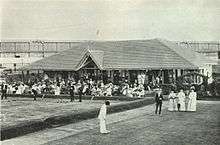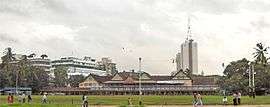Bombay Gymkhana
|
Picture of the Bombay Gymkhana | |
| Ground information | |
|---|---|
| Location | South Mumbai, Maharashtra, India |
| Establishment | June 19th 1875 |
| Capacity | 15,000 (but has held up to 50,000) |
| Owner | Brihanmumbai Municipal Corporation |
| Architect | Claude Batley |
| Operator | Bombay Gymkhana |
| Tenants |
Indian Rugby Team Local Clubs |
| End names | |
| n/a | |
| International information | |
| Only Test |
December 15, 1933: |
|
As of August 12 2015 Source: Bombay Gymkhana Ground, Cricinfo | |
Bombay Gymkhana (Marathi: मुंबई जिमख़ाना),(Hindi: मुंबई जिमख़ाना), established in 1875,[1] is one of the premiere gymkhanas (sports arena) in the city of Mumbai, India. Bombay Gymkhana Rugby Club (rugby union) are tenants.
It is located in the South Mumbai area and was originally built as a British-only club, designed by English architect, Claude Batley.[2]
The Gymkhana Grounds lie in the southern end of the Azad Maidan. The ground itself is on leased property. It has a triangular area, with the southern end facing the VSNL building. MG Road and H Somal Marg are the two roads on either end that begin from the southern end. It is boxed in by a shortcut lane which connects Churchgate to Victoria Terminus.
Sports
A long building which serves as the lobby, table tennis area, badminton court, restaurant and lounge connects the two roads. The region between the building and the lane is a large ground. It is very difficult to get membership into this exclusive club.[3]

Cricket is played here in the winter months, and rugby and football (soccer) in the monsoon months. This used to be major centre for the erstwhile Bombay Pentangular cricket matches. The ground had the distinction of hosting India's first Test cricket match on 15 December 1933,[4] captained by CK Nayudu. Temporary stands were put up at the ground to accommodate a record crowd of 50,000 people, with tickets selling at five times their usual price.[5] The match is remembered for Lala Amarnaths century, noted to be one of the best innings played in Indian cricket.[6] It hasn't hosted any senior matches since the Brabourne Stadium took its place in 1937, replacing the ground as the venue for the Bombay Pentangular as well as international matches.[7]
The Australian cricket team used the grounds to practice prior to their clash with India in the 1996 Cricket World Cup. In 2004, the Indian Women's team played a One Day International versus the Australian Women's team at Bombay Gymkhana.[8] In March 2010, Mumbai Indians played a practice match at the ground ahead of the IPL Season.[9] Later in the year, Canada played a match against a Bombay Gymkhana team to prepare of the World Cup in 2011.[10]
The ground also hosts a national rugby competition, and has recently hosted matches against Sri Lanka and a few other South Asian teams. It has also hosted national and international squash tournaments.
Bombay Gymkhana houses three badminton courts, five squash courts, six tennis courts, six tables for billiards and snooker, one swimming pool and a fitness centre.[11]
Until a few years ago, only men could gain membership to the club. Women were able to join from the early 2000s.

Test cricket
| Team (A) | Team (B) | Winner | Margin | Year |
|---|---|---|---|---|
| | | | By 9 wickets | 1933 |
Road widening controversy
The BMC wants to widen the adjacent Hazarimal Somani Marg from 50 feet to 80 feet and required about 6000 feet of land from the Bombay Gymkhana.[12] The gymkhana has been contenting the saying stating it's heritage status.[13] The Gymkhana has also been slapped with charges for illegally constructing additional buildings including a CEO's bunglow and wine shop.[14]
See also
References
- ↑ "Once Upon A Time: Bombay Gymkhana was first club to bring multiple sports together". 2016-08-21. Retrieved 2016-08-21.
- ↑ "Bombay gymkhana plans to shut kitchens: The History". Mid Day. Retrieved 2009-06-17.
- ↑ "New clubs on the block". Daily News and Analysis. Archived from the original on 5 December 2009. Retrieved 2009-06-17.
- ↑ "Gymkhana Ground: Test Matches". ESPN Cricinfo. 17 June 2011. Retrieved 17 June 2011.
- ↑ "When Test cricket came to India". ESPNCricinfo. 29 April 2006. Retrieved 28 February 2012.
- ↑ "'Pure romantic, Byron of Indian cricket'". The Hindu. 6 August 2000. Retrieved 28 February 2012.
- ↑ Anandji Dossa, Vasant Raiji (1987). CCI & the Brabourne Stadium, 1937-1987. Cricket Club of India. pp. 29–30.
- ↑ "Mithali Raj steers India home". ESPNCricinfo. 17 December 2004. Retrieved 28 February 2012.
- ↑ "Tendulkar rewinds time at the Bombay Gymkhana". ESPNCricinfo. 9 March 2010. Retrieved 28 February 2012.
- ↑ "Canada to tour India for World Cup preparations". ESPNCricinfo. 15 November 2010. Retrieved 28 February 2012.
- ↑ "Once Upon A Time: Bombay Gymkhana was first club to bring multiple sports together". 2016-08-21. Retrieved 2016-08-23.
- ↑ "Mumbai: BMC wants 6,000 sq m of Bombay Gymkhana land". Retrieved 2016-08-23.
- ↑ "Once Upon A Time: Bombay Gymkhana was first club to bring multiple sports together". 2016-08-21. Retrieved 2016-08-23.
- ↑ "Bombay Gymkhana row: CEO's bungalow, wine shop built without nod, says Collector". 2016-08-11. Retrieved 2016-08-23.
External links
| Wikimedia Commons has media related to Bombay Gymkhana. |
- Cricinfo Website - Ground Page
- HSBC Bombay Gymkhana Maharashtra State Open Squash Championship 2006 Results
- Club website
- cricketarchive Website - Ground Page
Coordinates: 18°56′14.75″N 72°49′52.36″E / 18.9374306°N 72.8312111°E
